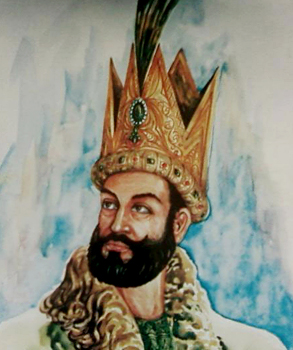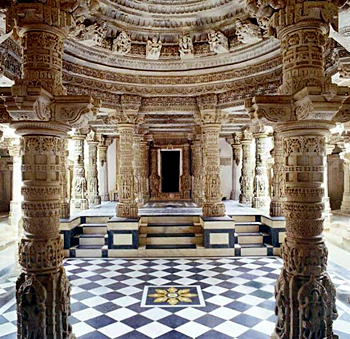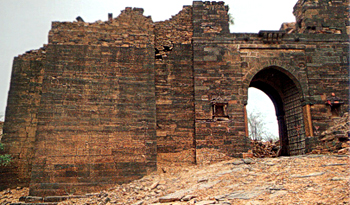 It is unclear whether the Chalukyas of Anhilwara were related to the Chalukyas of Southern India. However the Chalukyas of Anhilwara earned fame and assumed striking dignity during the rule of its founder Mularaja I. He consolidated the authority in Gujarat by overthrowing Samnatish Chavda and establishing the empire for what it is famous today. Mularaj Solanki was a powerful conqueror. Within a short span he was invaded by King of Ajmer in the north and King of Telangana in the south. He though managed to have a pact with the ruler in the North and defeated the southern king with his help. His kingdom included Saraswat and Satyapur Mandals, Kutch and some territories of Saurashtra. Several temples were constructed during his rule. His reign marked the start of a period during which Gujarati culture flowered as manifested in art, architecture, language and script. It is described as the golden period of Gujarat`s history.
It is unclear whether the Chalukyas of Anhilwara were related to the Chalukyas of Southern India. However the Chalukyas of Anhilwara earned fame and assumed striking dignity during the rule of its founder Mularaja I. He consolidated the authority in Gujarat by overthrowing Samnatish Chavda and establishing the empire for what it is famous today. Mularaj Solanki was a powerful conqueror. Within a short span he was invaded by King of Ajmer in the north and King of Telangana in the south. He though managed to have a pact with the ruler in the North and defeated the southern king with his help. His kingdom included Saraswat and Satyapur Mandals, Kutch and some territories of Saurashtra. Several temples were constructed during his rule. His reign marked the start of a period during which Gujarati culture flowered as manifested in art, architecture, language and script. It is described as the golden period of Gujarat`s history.
Chamund, his son was Mulraj`s successor. He was unable to expand his territory. Later he turned to be a womanizer. His sister Chachinidevi dethroned and gave it to his son Vallabhraj. Vallabhraj conquered King Sindhuraj`s territory though he died of illness thereafter. Durlabhraj brother of Vallabhraj could not extend the kingdom much. He was of good character. He invited Jain saints in his kingdom. He continued as Samant of Malav king Bhoj. His nephew Bhimdev succeeded the throne after his death. Modhera Sun Temple built by Bhimdev I.

Sultan Mahmud of Ghazni took over Anhilpur pattan. He fled and took shelter in Kanthkot fort in Kutch. Sultan Mahmud of Ghazni attacked Somnath temple, and destroyed it. United army of all kings under leadership of King Bhoj chased Sultan Mahmud. Bhimdev was the leading participant of the united army. Bhimdev and Bhoj jointly reconstructed the demolished Somnath temple. Bhimdev expanded his kingdom by including Saurashtra, Kutch, Abu and some parts of Khetak mandal and Mahimandals. Bhimdev has built many temples to his credit. Karandev, one of Bhimdev`s sons ascended the throne after Bhimdev`s death.
Karandev made friendship with King Someshwar of Kalyani. He added entire Lat in his kingdom. His territories touched Konkan in south and Naddul in north. Karan had built many temples, lakes and cities like Karnavati. Shakambhari`s king Dushshal Chauhan defeated and killed Karan in a war. Malav king Laxmdev and Naddul king Joggal helped in defeating Karandev. Patan`s condition was worse in the last days of Karandev. His son Jaysingh became Karandev`s descendant.
Siddharaj Jaysingh is one of the outstanding and prominent rulers of Solanki dynasty Siddhraj Jaysingh conquered Saurashtra, Kutch, and Malwa by defeating king Yashovarma. Siddharaj conquered the mountain-fortress of Junagadh. He became Chakravarti after acquiring total control of the region under old Gurjar Chakravarti kings. He constructed few lakes and renovated some structures. During his rule the regions flourished in education, religion and commerce. He gave shelter to many scholars of different religion and castes. The throne remained without King for eighteen days. Kumarpal, one of the sons of Bhimdev was suddenly declared King of Patan.There were many internal fights for this throne. He had to face much fight. Kumarpal adopted Jain religion along with Lord Shiva religion and became vegetarian. He built many Jain Vihars, renovated temples.
 Kumarpal`s nephew Ajaypal descended the throne. He was shrewd and got rid of all people connected to Kumarpal. Under his rule Patan`s rule remained from Gwalior to Narmada River. He discouraged Jain saints and leaders. After his death his child son Mulraj II was given Patan`s throne. Mulraj ruled for two years. His mother Naikdevi along with child Mulraj pushed back Islamic army of Shahbuddin Ghori. After his death Bhimdev II was the successor.
Kumarpal`s nephew Ajaypal descended the throne. He was shrewd and got rid of all people connected to Kumarpal. Under his rule Patan`s rule remained from Gwalior to Narmada River. He discouraged Jain saints and leaders. After his death his child son Mulraj II was given Patan`s throne. Mulraj ruled for two years. His mother Naikdevi along with child Mulraj pushed back Islamic army of Shahbuddin Ghori. After his death Bhimdev II was the successor.
Bhimdev II remained in top of an allied royal army to fight Muhammed Ghori and defeated him. Qutub-ud-din Aibak defeated Gujarat army near Mount Abu .Bhimdev hid himself in an unknown place. But he defeated Aibak adorned himself as "Abhinav Siddharaj" thereafter. Malav king Subhat varma invaded Gujarat subsequently. Bhimdev fled to either Saurashtra or Kutchh. During his absence a brave Chalukya named Jayansinh took over the kingdom of Gujarat, probably to save it. Bhimdev again came on the throne of Patan. After Bhimdev`s death his son, Tribhuvan Pal, was made the king.
Tribhuvan Pal was a king for namesake. In fact, Visaldev and Tejpal, sons of Mantri Virdhaval ruled Patan. During this period, Tejpal persuaded Visaldev to dethrone Tribhuvan pal. Visaldev took over the throne as a king after his death.
As a consequence the Solanki dynasty came to an end. Visaldev being a decedent from Arnoraj Vaghela`s son Lavanprasad, Vaghela dynesty ruled Patan. During the rule of the Chalukyas in Gujarat, architecture had developed considerably and reached it pinnacle. The beautiful Jaina shrine at Mount Abu is an example. Since the Solanki kingdom was prosperous huge amount of money was spent on the construction of beautiful Hindu and Jain temples.



















